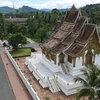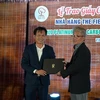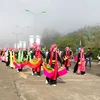 Mentioning Uoc Le, it immediately brings back memories for many people of the region’s famous ‘gio cha’ (pork paste). Uoc Le, known as the Chay village, is also rich in cultural traditions of a typical agricultural village of the northern region. The village's gate, one of the most beautiful of its kind still standing today, was built during the Mac Dynasty (1527-1627). Coming here, visitors can enjoy the fresh air in a peaceful and quiet village with green bamboo, areca trees, and time-worn walls. Traces of the past can be found on each rock slab, each mossy wall of the house, the well, and the market dome. (Photo: VietnamPlus)
Mentioning Uoc Le, it immediately brings back memories for many people of the region’s famous ‘gio cha’ (pork paste). Uoc Le, known as the Chay village, is also rich in cultural traditions of a typical agricultural village of the northern region. The village's gate, one of the most beautiful of its kind still standing today, was built during the Mac Dynasty (1527-1627). Coming here, visitors can enjoy the fresh air in a peaceful and quiet village with green bamboo, areca trees, and time-worn walls. Traces of the past can be found on each rock slab, each mossy wall of the house, the well, and the market dome. (Photo: VietnamPlus)  In contrast to the bustle and modern buildings of the capital city, Uoc Le ancient village still retains the ancient and rustic features of a typical northern countryside with banyan trees, communal wells and courtyards. Uoc Le village makes a special impression right from the village gate, which is located behind a small curved bridge over a small moat. The gate bears three words: ‘Uoc Le Mon’, which means ‘Uoc Le Gate’. On both sides of the gate, there are a pair of parallel sentences in Han (Chinese charaters), expressing the wish for the villagers to do business smoothly and successfully when going out. (Photo: VietnamPlus)
In contrast to the bustle and modern buildings of the capital city, Uoc Le ancient village still retains the ancient and rustic features of a typical northern countryside with banyan trees, communal wells and courtyards. Uoc Le village makes a special impression right from the village gate, which is located behind a small curved bridge over a small moat. The gate bears three words: ‘Uoc Le Mon’, which means ‘Uoc Le Gate’. On both sides of the gate, there are a pair of parallel sentences in Han (Chinese charaters), expressing the wish for the villagers to do business smoothly and successfully when going out. (Photo: VietnamPlus)  The village gate is an architectural work which comprises two floors. Below is a plain brick wall, and a wide archway. Above is a watch tower with a plate written with the words ‘My tuc kha phong’ which means ‘Good customs to be followed’. These four words were given by the court in 1851 because Uoc Le village used to have a fund dedicated to saving the poor. This shows that Uoc Le was a well-off village with a tradition of mutual love and respect. Surrounding the gate and the whole village is a small moat and thick bamboo hedges, the typical features of a northern countryside, to protect the village from thieves. (Photo: VietnamPlus)
The village gate is an architectural work which comprises two floors. Below is a plain brick wall, and a wide archway. Above is a watch tower with a plate written with the words ‘My tuc kha phong’ which means ‘Good customs to be followed’. These four words were given by the court in 1851 because Uoc Le village used to have a fund dedicated to saving the poor. This shows that Uoc Le was a well-off village with a tradition of mutual love and respect. Surrounding the gate and the whole village is a small moat and thick bamboo hedges, the typical features of a northern countryside, to protect the village from thieves. (Photo: VietnamPlus)  According to the elderly in the village, the four words ‘My tuc kha phong’ were given by the court in 1851 because Uoc Le village used to have a fund dedicated to saving the poor. This shows that Uoc Le was a well-off village with a tradition of mutual love and respect. Surrounding the gate and the whole village is a small moat and thick bamboo hedges, the typical features of a northern countryside, to protect the village from thieves, thus helping locals enjoy a peaceful life. The village gate has an arch which resembles the roof of ancient pagodas in Vietnam. (Photo: VietnamPlus)
According to the elderly in the village, the four words ‘My tuc kha phong’ were given by the court in 1851 because Uoc Le village used to have a fund dedicated to saving the poor. This shows that Uoc Le was a well-off village with a tradition of mutual love and respect. Surrounding the gate and the whole village is a small moat and thick bamboo hedges, the typical features of a northern countryside, to protect the village from thieves, thus helping locals enjoy a peaceful life. The village gate has an arch which resembles the roof of ancient pagodas in Vietnam. (Photo: VietnamPlus)  The village gate was decorated with patterns which bore the art style of the Mac Dynasty (1527-1627). Uoc Le has two gates, with the main built hundreds of years ago, and the auxiliary in 1998. Uoc Le village makes a special impression right from its gate, which is located behind a small curved bridge over a small moat. The gate bears three words: ‘Uoc Le Mon’, which means ‘Uoc Le Gate’. On both sides of the gate, there are a pair of parallel sentences in Han (Chinese characters), expressing the wish for the villagers to do business smoothly and successfully when going out beyond the village perimeter. (Photo: VietnamPlus)
The village gate was decorated with patterns which bore the art style of the Mac Dynasty (1527-1627). Uoc Le has two gates, with the main built hundreds of years ago, and the auxiliary in 1998. Uoc Le village makes a special impression right from its gate, which is located behind a small curved bridge over a small moat. The gate bears three words: ‘Uoc Le Mon’, which means ‘Uoc Le Gate’. On both sides of the gate, there are a pair of parallel sentences in Han (Chinese characters), expressing the wish for the villagers to do business smoothly and successfully when going out beyond the village perimeter. (Photo: VietnamPlus)  On the backside of the gate, there are three words 'Thieu cao dai', which mean that the previous generations of the village have done many virtuous deeds, so the next generations will definitely prosper. It is also a reminder that villagers, wherever they go, should live ethically and know how to do good deeds to leave merit for their children and grandchildren. Visitors to Uoc Le will be given an opportunity to learn about the trade of making pork paste. Uoc Le’s pork paste making began around a century ago. According to the village records, during the Mac Dynasty, a concubine in the imperial court who was a Uoc Le native helped villagers build the impressive village gate and taught them how to make pork paste. (Photo: VietnamPlus)
On the backside of the gate, there are three words 'Thieu cao dai', which mean that the previous generations of the village have done many virtuous deeds, so the next generations will definitely prosper. It is also a reminder that villagers, wherever they go, should live ethically and know how to do good deeds to leave merit for their children and grandchildren. Visitors to Uoc Le will be given an opportunity to learn about the trade of making pork paste. Uoc Le’s pork paste making began around a century ago. According to the village records, during the Mac Dynasty, a concubine in the imperial court who was a Uoc Le native helped villagers build the impressive village gate and taught them how to make pork paste. (Photo: VietnamPlus)  About 50m strait from the village gate is the traditional ancient market which lies in the shade of big trees. According to old villagers, since the main gate of the village was built, the market began. It is held within only two hours in the early morning. Therefore, traders must bring food to the market early to sell to local people, and locals also have to get up early to go to the market to buy food in preparation for their meals. The tile roofs of the market are tinged with time and bring a sense of nostalgia. They also carry cultural imprints of past historical periods. (Photo: VietnamPlus)
About 50m strait from the village gate is the traditional ancient market which lies in the shade of big trees. According to old villagers, since the main gate of the village was built, the market began. It is held within only two hours in the early morning. Therefore, traders must bring food to the market early to sell to local people, and locals also have to get up early to go to the market to buy food in preparation for their meals. The tile roofs of the market are tinged with time and bring a sense of nostalgia. They also carry cultural imprints of past historical periods. (Photo: VietnamPlus)  The tile roofs of the market are tinged with time, and bring a sense of nostalgia. They also carry the cultural imprints of past historical periods. Many Uoc Le folks immediately remember the famous ‘gio cha’ (pork paste). As rice is a staple of Vietnamese daily meals, then ‘gio cha’ is considered the staple of special occasions, such as Tet (Lunar New Year), wedding parties and ancestors’ death commemoration. The best quality ‘gio’ can be traced back to Uoc Le. There are no official documents about the genesis of ‘gio’ in the village, but according to the elderly, Uoc Le people have been making ‘gio’ for at least 100 years. (Photo: VietnamPlus)
The tile roofs of the market are tinged with time, and bring a sense of nostalgia. They also carry the cultural imprints of past historical periods. Many Uoc Le folks immediately remember the famous ‘gio cha’ (pork paste). As rice is a staple of Vietnamese daily meals, then ‘gio cha’ is considered the staple of special occasions, such as Tet (Lunar New Year), wedding parties and ancestors’ death commemoration. The best quality ‘gio’ can be traced back to Uoc Le. There are no official documents about the genesis of ‘gio’ in the village, but according to the elderly, Uoc Le people have been making ‘gio’ for at least 100 years. (Photo: VietnamPlus)  Banyan trees, communal wells and yards, and bamboo hedges are images associated with the typical village culture of the northern region. In contrast to the bustle and modern buildings of the capital city, Uoc Le ancient village still retains the ancient and rustic features of a typical northern countryside with banyan trees, communal wells and courtyards, and bamboo hedges. Surrounding the main gate and the village is a small moat and thick bamboo hedges, the typical features of a northern countryside. These protect the village from thieves, thus helping locals enjoy a peaceful life. Along the roads in the village, locals also grow rows of bamboo. (Photo: VietnamPlus)
Banyan trees, communal wells and yards, and bamboo hedges are images associated with the typical village culture of the northern region. In contrast to the bustle and modern buildings of the capital city, Uoc Le ancient village still retains the ancient and rustic features of a typical northern countryside with banyan trees, communal wells and courtyards, and bamboo hedges. Surrounding the main gate and the village is a small moat and thick bamboo hedges, the typical features of a northern countryside. These protect the village from thieves, thus helping locals enjoy a peaceful life. Along the roads in the village, locals also grow rows of bamboo. (Photo: VietnamPlus)  Many households in Uoc Le still keep their ancient houses and gates dating back over 100 years. Although the houses have changed over the years, local people are still trying to keep the ancient gates in an attempt to retain part of the culture of their ancestors. Through many years of ups and downs, the house gates still keep the ancient and majestic beauty, a pride of family members. It is also one of the attractions of Hanoi, drawing a lot of people, especially on weekends and holidays. Visiting Uoc Le village, travellers can immerse themselves in the quiet, ancient beauty of its landscape. (Photo: VietnamPlus)
Many households in Uoc Le still keep their ancient houses and gates dating back over 100 years. Although the houses have changed over the years, local people are still trying to keep the ancient gates in an attempt to retain part of the culture of their ancestors. Through many years of ups and downs, the house gates still keep the ancient and majestic beauty, a pride of family members. It is also one of the attractions of Hanoi, drawing a lot of people, especially on weekends and holidays. Visiting Uoc Le village, travellers can immerse themselves in the quiet, ancient beauty of its landscape. (Photo: VietnamPlus)  The brick walls imprinted with traces of the time bring familiarity and antiquity. This is a common image to please the eyes of visitors when they stroll around Uoc Le village. Besides the modern concrete walls, the brick ones still boast a typical nostalgic beauty. Many families in Uoc Le keep their ancient houses and gates dating back over 100 years. As the houses have changed over the years, yet local people are trying to keep the ancient gate in an attempt to retain part of the culture of the ancestors. Through many years of ups and downs, the house gates keep the ancient and majestic beauty, a pride of family members. (Photo: VietnamPlus)
The brick walls imprinted with traces of the time bring familiarity and antiquity. This is a common image to please the eyes of visitors when they stroll around Uoc Le village. Besides the modern concrete walls, the brick ones still boast a typical nostalgic beauty. Many families in Uoc Le keep their ancient houses and gates dating back over 100 years. As the houses have changed over the years, yet local people are trying to keep the ancient gate in an attempt to retain part of the culture of the ancestors. Through many years of ups and downs, the house gates keep the ancient and majestic beauty, a pride of family members. (Photo: VietnamPlus)  The family of 74-year-old Tru still maintains the old house dating back hundreds of years. According to him, the house was bought from a family in the village when his grandfather was young. It is not difficult to recognise that bamboo awnings are a typical feature of most of the old houses in Uoc Le village as well as in others in the northern region. Tru said that in the past, the ancestors had bamboo awnings fixed in front of the house to prevent people from looking in directly and going straight to the centre of the house - the place where the altar is usually placed. The bamboo awnings could be used to block the sun as most of the houses are west-facing. (Photo: VietnamPlus)
The family of 74-year-old Tru still maintains the old house dating back hundreds of years. According to him, the house was bought from a family in the village when his grandfather was young. It is not difficult to recognise that bamboo awnings are a typical feature of most of the old houses in Uoc Le village as well as in others in the northern region. Tru said that in the past, the ancestors had bamboo awnings fixed in front of the house to prevent people from looking in directly and going straight to the centre of the house - the place where the altar is usually placed. The bamboo awnings could be used to block the sun as most of the houses are west-facing. (Photo: VietnamPlus)  It is not difficult to recognise that bamboo awnings are the typical feature of most of the old houses in Uoc Le village as well as in others in the northern region. Tru said that in the past, the ancestors had bamboo awnings in front of the house to prevent people from looking in directly and going straight to the centre of the house - the place where the altar was usually placed. The bamboo awnings could be used to block the sun as most of the houses are west-facing. Although his 100-year-old house has undergone several renovations, Tru only re-paved the floor and kept the original wooden parts to preserve the value of the house. (Photo: VietnamPlus)
It is not difficult to recognise that bamboo awnings are the typical feature of most of the old houses in Uoc Le village as well as in others in the northern region. Tru said that in the past, the ancestors had bamboo awnings in front of the house to prevent people from looking in directly and going straight to the centre of the house - the place where the altar was usually placed. The bamboo awnings could be used to block the sun as most of the houses are west-facing. Although his 100-year-old house has undergone several renovations, Tru only re-paved the floor and kept the original wooden parts to preserve the value of the house. (Photo: VietnamPlus)  In addition to the old houses, wells are also one of the features of Uoc Le village. Uoc Le village is home to six wells, most of which are associated with religious works such as communal houses and pagodas. In this photo is the well at the Hau Pagoda. According to local culture researchers, ancient wells vividly reflect the long-lasting cultural and historical values that need to be preserved for future generations. They also reflect the spiritual lives of the inhabitants. It is time, therefore, to develop plans to preserve and uphold the great historical and cultural values of these special wells. (Photo: VietnamPlus)
In addition to the old houses, wells are also one of the features of Uoc Le village. Uoc Le village is home to six wells, most of which are associated with religious works such as communal houses and pagodas. In this photo is the well at the Hau Pagoda. According to local culture researchers, ancient wells vividly reflect the long-lasting cultural and historical values that need to be preserved for future generations. They also reflect the spiritual lives of the inhabitants. It is time, therefore, to develop plans to preserve and uphold the great historical and cultural values of these special wells. (Photo: VietnamPlus)  Uoc Le ancient village also has an auxiliary gate built in 1998. Although it does not have as high historical and architectural values as the main gate, it is also a symbolic part of the village. Uoc Le village makes a special impression right from its gate, which is located behind a small curved bridge over a small moat. The gate bears three words: ‘Uoc Le Mon’, which means ‘Uoc Le Gate’. On both sides of the gate, there are a pair of parallel sentences in Han (Chinese charaters), expressing the wish for the villagers to do business smoothly and successfully when going out. (Photo: VietnamPlus)
Uoc Le ancient village also has an auxiliary gate built in 1998. Although it does not have as high historical and architectural values as the main gate, it is also a symbolic part of the village. Uoc Le village makes a special impression right from its gate, which is located behind a small curved bridge over a small moat. The gate bears three words: ‘Uoc Le Mon’, which means ‘Uoc Le Gate’. On both sides of the gate, there are a pair of parallel sentences in Han (Chinese charaters), expressing the wish for the villagers to do business smoothly and successfully when going out. (Photo: VietnamPlus) VNA



















